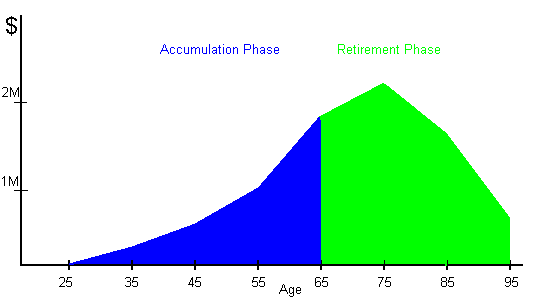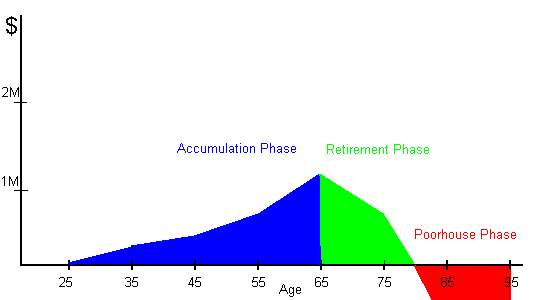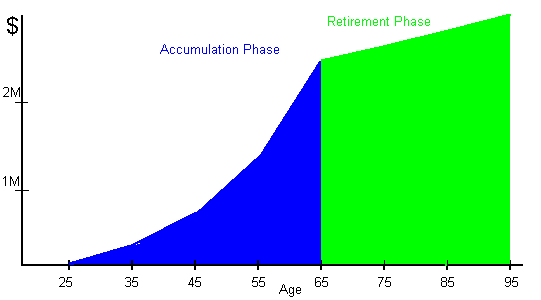- How much money will you save each month toward retirement? Generally you will deposit this money into your 401(k) account at work or into a normal IRA account. If you work for yourself you can use a SEP or KEOGH account that you set up with your bank.
- What interest rate will your money earn before and during retirement? Generally you will use more aggressive investments (like stock mutual funds) prior to retirement to help your money grow faster, and then move the money to safer investments (like bond mutual funds, annuities or CDs) while in retirement to keep it safe.
- What inflation rate will affect both your buying power and your salary? Over 20 or 30 or 40 years inflation will increase the cost of everything. It will also increase your monthly income during the accumulation phase. Inflation has averaged about 4% over the last 10 years or so, and the calculator allows you to take its affects into account.
- At what age do you wish to retire? You can choose an early retirement if you can save a big enough nest egg.
- How much money will you spend per year during retirement? You determine this number in today's dollars, and the calculator figures out the effects of inflation for you. To determine this number, look at your living expenses today (see the Cash Flow Calculator to help determine this number) as a starting point. Then try to factor in which expenses will go down (for example housing, commuting expenses, etc.), and which will go up (medical insurance, leisure expenses if you plan to travel, etc.) to arrive at a figure. Many experts recommend 80% of current expenditures as a ballpark figure.
- Salary: $36,000
- Contribution Percentage: Bob, after reading these articles, has decided to contribute 10% to his 401(k) account. He would like to save 15%, but just doesn't feel that is possible.
- Matching Percentage: Bob's company matches at a rate of 50% for the first 6% of employee contributions (with no additional match for higher contributions). Therefore Bob's matching percentage is 3%.
- Pre-retirement Interest Rate: Bob is investing his 401(k) money in stock mutual funds, so he is hoping for a 10% rate of return prior to retirement.
- Post-retirement Interest Rate: Bob has no idea what he will do with his money once he retires. However, to be safe he is using a lower 6% rate for post-retirement return.
- Inflation rate: Bob is using the historical average of 4%.
- Salary increase rate: At his last yearly performance review, Bob got a 4% cost of living increase and a 5% raise based on his performance, for a total of a 9% raise. He feels uncomfortable using 9% as the salary increase rate for every year, however, because he feels that is too optimistic. At the same time, he feels that his salary will increase faster than inflation. Therefore, he is using a 6% value here as a compromise.
- Current 401(k) value: The current balance is zero because he is just starting out.
- Current age: Bob is 25 now.
- Expected retirement age: 65.
- Desired retirement income: Bob wants to have a comfortable retirement, with a lot of traveling. He plans to have bought a house and paid it off by the time he retires. However, he knows that will be offset by high medical insurance rates. Therefore, he wants to have $40,000 per year available during retirement in today's dollars. He is expecting that social security will survive, but feels it will be drastically scaled back. He forsees receiving perhaps $5,000 per year from social security in today's dollars. Therefore he enters $35,000 in this field.
Understanding and Controlling Your Finances
Retirement Planning
by Marshall Brain"Retirement Planning" is the honest attempt to figure out how much money you need to save each month in order to have a comfortable retirement. The reason I say "honest attempt" is because retirement planning requires you to predict the future, and we all know that is impossible. For example, what sort of return will your money get over the next 20 or 30 or 40 years? What will happen with inflation? Will Social Security still exist when you retire, and if so how much money will you get from it? It is impossible to predict any of these things with total certainty.
However, it is possible to look at the past and make some educated guesses. That is the goal of retirement planning. You make a basic and fundamental assumption that the world will work something like it has in the past. Then you factor in your own optimism or pessimism about the future to correct for the changes you foresee.
Saving for retirement involves a long-term effort to accumulate a nest egg big enough to support you during your years in retirement. The goal of retirement planning is to determine how big the nest egg needs to be to support you comfortably. The following graph shows how you how a nest egg might be accumulated prior to retirement and then depleted during retirement:

This graph shows a 40 year accumulation phase that results in a retirement nest egg on the order of $2,000,000 ($2M), retirement at age 65, and then a retirement phase ending at age 95 with money left in the bank.
There are other possible graphs, or course. The following is less appealing:

This graph shows an accumulation phase that, even though it reached $1M, fails to meet the requirements of retirement, and then a very bad deficit occuring during retirement.
The following graph shows the opposite:

Here a large nest egg accumulated during the accumulation phase, and the account balance actually grows during retirement. This approach will make your heirs or alma mater happy to see you coming.
You can determine what your retirement is likely to look like by using the calculator provided below. To use it, you will have to answer several questions:
Once you have determined these numbers, you can see whether your retirement plan is sound or flawed using the retirement calculator. Try different scenarios and see how your plan works. As an example of how you might use the calculator, let's look at Bob's retirement plan and see how he is doing.
As you may recall from earlier articles, Bob is a 25 year old computer programmer making $36,000 right now. Here are his answers to different questions in the retirement calculator:
 | You can use the Retirement Planning calculator to help you calculate how much money you need to be saving for retirement in your 401(k) (or other) plan. (To run this calculator you will need a web browser that understands JavaScript. The later versions of NetScape, the MS Internet Explorer, etc. all do) |

BYG Publishing, Inc.
http://www.bygpub.com - info@bygpub.com
P.O. Box 40492 - Raleigh, NC 27629
Questions or comments, email:
questions@bygpub.com
© 1997 BYG Publishing, Inc.
